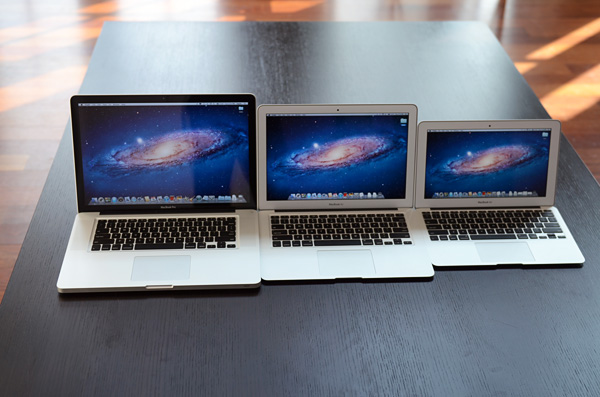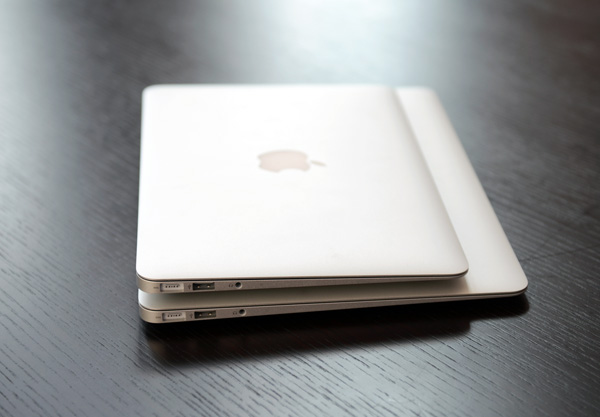The 2011 MacBook Air (11 & 13-inch): Thoroughly Reviewed
by Anand Lal Shimpi on July 28, 2011 3:25 AM EST- Posted in
- Apple
- Mac
- Intel
- Sandy Bridge
- MacBook Air
- Laptops
Final Words
Whereas last year's MacBook Air was a good machine for light work, the 2011 models are true replacements for mainstream portable Macs. There's still no dethroning the MacBook Pro (although the 13-inch model clearly needs a higher resolution display option), but for the rest of the world there are now some excellent ultra portable options that don't force you to really compromise on performance.
Both the 11 and 13-inch MacBook Air are fast enough to replace your 3 year old MacBook Pro and still deliver better performance. You can even move from a 2010 MacBook Pro to an upgraded MacBook Air and not notice any drop in performance. All of this is thanks to Intel's Sandy Bridge CPU.

From left to right: 15-inch MacBook Pro, 13-inch MacBook Air, 11-inch MacBook Air
It's the GPU performance that I'm less excited about. While last year's GeForce 320M isn't significantly faster than the HD 3000 in the new MacBook Air, it's still faster in our tests. There's not much Apple could've done about this. I don't believe a discrete GPU in an Air makes sense, but this should be a clear message to Intel. Sandy Bridge's GPU is the bare minimum, we need to really see a real ramp in performance from here on out. Ivy Bridge will give us a bit of that but not another doubling in GPU performance. Perhaps we'll see something significant from Haswell in 2013. For now, if you like gaming on the go you'll have to get a MacBook Pro.
When it comes to battery life the new MacBook Air doesn't break any records, but it doesn't disappoint either (at least under OS X). With the exception of the our light web browsing test, the new MacBook Air behaves pretty similarly to last year's model on battery power. The new 13 doesn't do anywhere near as well in mostly idle scenarios but under moderate to heavy load the new MBAs last at least as long as their predecessors.
The only move I would be careful about is a downgrade from a 13-inch 2011 MacBook Pro. The new 13-inch MBP is still considerably faster than the MacBook Air, while the more portable form factor is tempting you're better off waiting to see what Apple does with the next update to the MacBook Pro.
If you were a fan of the original MacBook Air, the 2011 models are just as significant of an introduction as the very first one in 2008. They may not look any different from the outside, but the new 11 and 13-inch MacBook Air are a significant step forward. These systems are no longer niche ultraportables, they've instead brought the ultraportable niche into the mainstream.
If you're stuck deciding between the two I think it breaks down like this. If you've got a beefy system at home and just need something portable for travel, the 11-inch Air is perfect. It's now fast enough to get real work done on the road and portable enough to feel like a tablet with an integrated keyboard. If you're replacing a primary notebook however, the 13 is the safer bet. It is sized like a normal notebook, you get longer battery life and a bigger screen to look at. If you're a fan of extremes, the 11 is for you. If you like balanced compromises, go with the 13.
What happens from here on out is what's really interesting. Intel has already committed to moving the TDP of its mainstream parts from 35W - 45W down to 10 - 20W. Since the Air is the new mainstream Mac notebook, Apple has already made that move. The performance in this 10 - 20W segment is going to get much better over the next two years, particularly once Haswell arrives.
The Thunderbolt Display is the first sign of what's to come. Moving IO controllers and expansion into the display, and potentially even moving discrete GPUs out of the notebook are all in store for us. Apple is really ahead of the curve here, but it's easy to imagine a future where laptops become a lot more like the new Air and shift to a couple high bandwidth ports instead of numerous lower bandwidth connections.
There's a lot to like with the new MacBook Airs; the last update was good, but performance was still often lacking. The MBA 11 in particular is now much more useful, and the 13 rightfully spells the end of the line for the old MacBook. While pricing is higher than typical 11" to 13" Windows laptops, you really can't find a competing Windows laptop with all the features the MBA offers without paying a similar price premium. You get a nice chassis with excellent build quality, decent displays that trump every budget laptop we've looked at, and reasonable battery life. If you like thin and light ultraportables, the MacBook Air continues to be one of the best options around.











103 Comments
View All Comments
darwinosx - Saturday, July 30, 2011 - link
There is barely any difference between Elitebook models to talk about. Nor is there anything particularly special about them. Just another Windows clone made and supported a little better than what HP sells at Best Buy. Given that, it was covered quite well.OCedHrt - Thursday, July 28, 2011 - link
This is so last year. This is not even what I got in my Sony Z last year. For $1600. 2.4 ghz i5 (520m), GT 330M in 3 lb chasis with internal dvdrw. And that was bottom of the line. Not to mention I got mine from MSFT with 40% off.This year: http://store.sony.com/webapp/wcs/stores/servlet/Ca...
Of course this one costs way more, but still worth a though.
beginner99 - Thursday, July 28, 2011 - link
lol yeah. Sony is the only brand that has even more ridiculous pricing than Apple. You say it yourself 40% off. And in this case I say apple's pricing is very competitive and I'm an "apple-hater". Never owned a single device from them, not even an Ipod.The new base model Vaio Z will also be about 40% more expensive at half of the SSD capacity.
Anyway, I would have already bought it, if it was a windows system.
Johnmcl7 - Thursday, July 28, 2011 - link
I wouldn't say Sony's pricing is ridiculous as you're paying for absolutely cutting edge tech whereas with Apple . The previous Z series may have been pricey but it featured a 13.1 1080p screen (genuine 1920x1080), up to an i7 dual core processor, quad SSDs in RAID 0, dual graphics graphics cards (one integrated, one discrete), blu-ray writer which even Apple's 17in machines couldn't match but was smaller and lighter than Apple's 13in machines.I have the Vaio from the previous generation (Z5) which has a C2D 3Ghz processor, 13.1 1600x900 screen, dual 128GB mSSDs in RAID 0, blu-ray writer and integrated & discrete graphics cards which again Apple didn't offer anything even remotely comparable. Speccing up a Macbook to the maximum level put it far above the Vaio in cost but far below in spec with just a 2.6Ghz processor, DVD burner, single graphics card and low resolution screen.
John
darwinosx - Saturday, July 30, 2011 - link
Kids, read the review and learn something before commenting. No Sony has this proc in it yet. Also learn something about cpu speed in different processor models. Finally try to understand that this laptop is meant to be super thin and lightweight which the Sony is not. It is also top quality construction support and uses a modern OS.OCedHrt - Tuesday, August 2, 2011 - link
The sony from last year is nearly the same weight at 3.1 lb with an internal optical drive and the new one this year is much lighter at 2.5 lbs with external.The Sony Z specifically do not use ULV processors for maximum performance:
Intel® Core™ i5-2410M processor (2.30GHz) with Turbo Boost up to 2.90GHz
Intel® Core™ i5-2540M processor (2.60GHz) with Turbo Boost up to 3.30GHz
Intel® Core™ i7-2620M processor (2.70GHz) with Turbo Boost up to 3.40GHz
The base processor already matches the top of the line Air processor in turbo and far exceeds it in other conditions.
So to recap: Sony Z from last year (Z11-Z14) is already super thin and light weight at significantly faster performance for same cost, and sometimes cheaper when Microsoft Store has a crazy sale.
Sony Z for this year Z21 is even thinner and lighter at even faster performance for a slight premium. Remember the lowest Z performs better than the fastest Air. $1969 vs $1599 gives you an external dvdrw and discrete graphics and usb 3.0. That's not a bad deal at all.
Keep in mind the fastest Z will kill the Air in performance all in the same chasis. And battery life from reviews indicate the new Z is on-pair with Air (4+ hours with a movie playing continouously).
OCedHrt - Tuesday, August 2, 2011 - link
$1600 was not 40% off. I got mine for $1100. $1600 is the retail price at B&M for the entry level model that I outlined (with 64gb x2 SSD).ViRGE - Thursday, July 28, 2011 - link
Looking at the specs, something doesn't make sense. They're using 35W TDP processors and claiming better battery life on a smaller battery than the 13" MBA. The math doesn't add up on that one.KPOM - Thursday, July 28, 2011 - link
Might Sony be including the optional "sheet battery" in that time?ViRGE - Thursday, July 28, 2011 - link
Nope. They break that out separately.